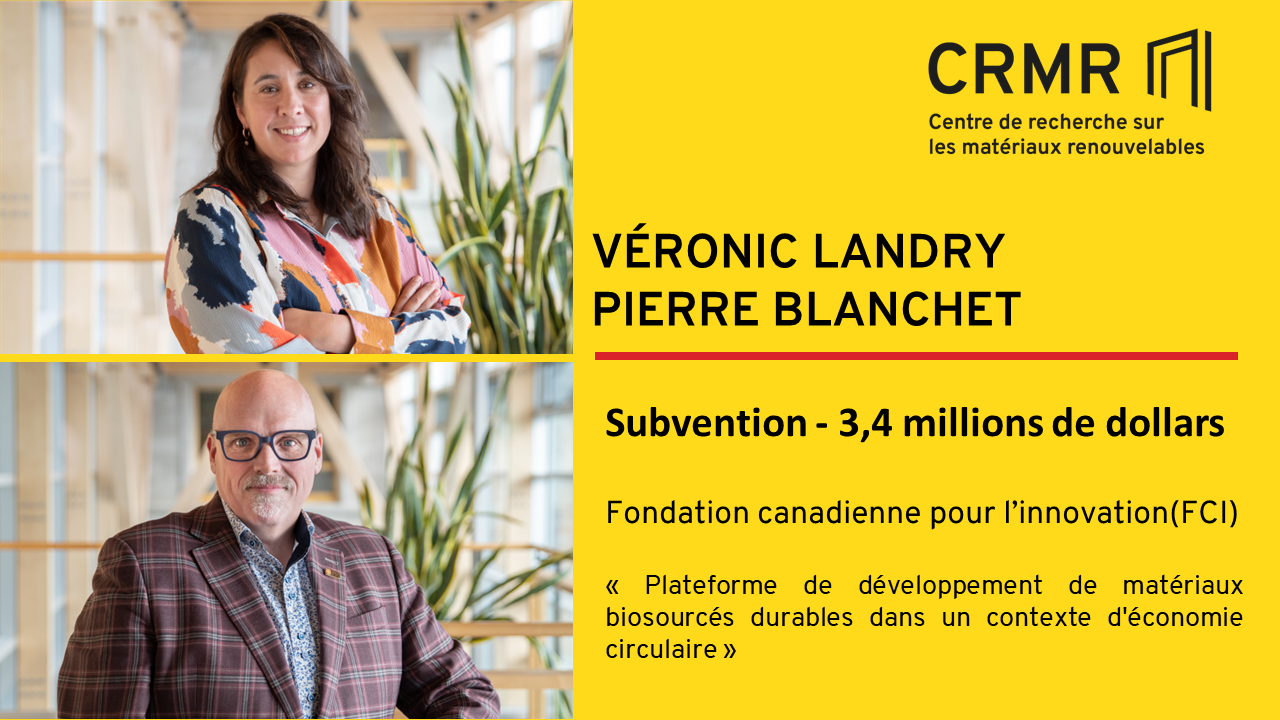Congratulations to Véronic Landry and Pierre Blanchet, who have been awarded a major grant of $3.4 million from the Canada Foundation for Innovation (CFI)!
We are pleased and proud to share that the project entitled « Platform for the development of Sustainable Bio-based materials in a circular economy context » has been awarded major funding of $3.4 million by the Canada Foundation for Innovation (CFI). This project, co-directed by Véronic Landry and Pierre Blanchet, two eminent professors at the Faculty of Forestry, Geography, and Geomatics (FFGG) of the Laval University, and regular members of the renewable materials research centre (CRMR), promises significant advances in the characterization and valorization of wood residues, as well as in the development of co-products from wood processing as part of a circular economy.
More specifically, this project aims to develop various products such as coatings, adhesives, membranes, bio-based insulation, structural products, and composite panels using the adhesives developed. The ambitious scope of this project also includes extending the use of wood products in multi-storey building construction. Work will be undertaken in the field of fire safety and timber-concrete structures to promote the integration of wood materials in this type of construction.
This substantial funding will allow completing extensive and innovative research, which will have a positive impact on sustainable development and the promotion of the circular economy. Congratulations to all the team involved in this promising project!

PROJECT DETAILS
Overview of the project
In recent years, the forestry industry has gradually moved away from the linear economy model towards the circular economy model, which advocates optimizing resources and energy. The recovery of residues and co-products from wood processing, as well as the eco-design of materials with a low environmental impact, have been among the strategies favoured to achieve this. However, the end-of-life of glued, finished or impregnated products remains a major issue. The aim of the proposed research programme will therefore be to develop, characterize and add value to sustainable bio-based materials based on local supplies in line with the circular economy model, i.e. by ensuring that the products and co-products generated are recycled and upgraded. All the work will be carried out in a spirit of sustainable development, since as well as working with local, bio-based raw materials, environmental performance will be taken into account in the product development cycle, notably through life cycle analyses. These analyses will be incorporated into the early stages of several of the projects presented, and will dictate the direction of research.
Objectives and research areas
The specific objectives are as follows:
- Extract, characterize and/or add value to the components of wood, enabling the development of bio-sourced construction and convenience materials;
- Develop adhesives, finishing products, insulation and membranes with a low environmental impact that are bio-based and/or incorporate stimuli-sensitive functions of interest;
- Develop composite materials with low environmental impact and rethink their end-of-life cycle to improve their environmental performance;
- To develop and evaluate innovative construction systems that push back the technical limits of timber buildings
The research programme will be divided into four interrelated areas, to ensure consistency in research orientations and to move towards the circular economy model. The raw materials extracted and characterized or to be recovered in axis 1 will be used to prepare various materials in axes 1 and 2, and incidentally will have an impact on the wood products developed in axis 3 (composites) and 4 (structural products). Residues generated during the manufacture of materials prepared in Axes 3 and 4 will be reused in Axis 1.
- Axis 1 will focus on the preparation, characterization and valorization of forest biomass for commodity products. The work in this area will involve extracting compounds from Canadian forest biomass and characterizing them in order to determine their properties, chemical composition and potential for incorporation into various materials. Activity 1.1 focuses on the potential use of lignins, while activity 1.2 assesses the potential use of cellulose filaments (CF) in the development of a wide variety of materials other than those typically used in the wood construction industry.
- Axis 2 will focus on the development of biobased adhesives, finishing and densification products and insulation, using mainly Canadian renewable raw materials (activity 2.1). In addition, in order to increase the performance of coatings and adhesives and, incidentally, their service life, various stimuli-sensitive functions will be integrated (i.e., polymers that exhibit physical or chemical changes under the action of an external stimulus) (activity 2.2).
- Axis 3 will focus on the development of a new generation, high value-added wood-based composite panels. This area will include work on composite panels for the timber construction industry, as well as work on the modification and impregnation of wood. The adhesives developed in axis 2 will be evaluated by preparing composite panels (activity 3.1). Work is also planned on identifying and evaluating alternative sources of supply for composite panels (activity 3.2) and on managing the end-of-life of panels (activity 3.3). Finally, work on the impregnation and modification of wood to stabilize and harden it is also planned (activity 3.4).
- Axis 4 will focus on the development and evaluation of innovative structural products based on or including wood. This axis will be directly linked to axis 2, via activity 4.1, while the adhesives developed could be integrated into various structural products, including cross-laminated timber (CLT) structural products. Activity 4.2 covers work on pushing back the limits of the use of wood in multi-storey buildings. Finally, activity 4.3 will enable us to study different timbers-concrete structures.
Research team
The project will be led by Véronic Landry and Pierre Blanchet, two professors in the Department of Wood and Forest Sciences at Laval University. The team also includes co-applicants from the Laval University-CRMR (Alain Cloutier, Alexis Achim, Christian Dagenais, Luca Sorelli and Tatjana Stevanovic), a professor from the École de technologie supérieure (Annie Levasseur) and a researcher from Serex (Papa Nikhor Diouf).
Equipments
The project infrastructure comprises equipment in three categories: 1) raw material and materials preparation equipment, 2) chemical and physical characterization equipment and 3) equipment for assessing mechanical and in-service performance. The main pieces of equipment to be acquired include mixers for particles and lamellae for making composite panels, a gas chromatograph with a pyrolyser for studying the extracted lignin and measuring the volatile organic compounds released by the various products prepared (adhesives, coatings, insulation, membranes) and a nano-micro-indentor for carrying out various mechanical tests.
List of equipments
| 1 | Broyeur |
| 2 | Réacteur Parr |
| 3 | Évaporation grand volume |
| 4 | Presse automatique |
| 5 | Micro-extrudeuse à double vis de table |
| 6 | Presse de moulage par compression |
| 7 | Mélangeur pour panneaux composites (lamelles) |
| 8 | Mélangeur pour panneaux composites (particules) |
| 9 | Rhéométre avec accessoire UV |
| 10 | Appareil de mesure du temps de séchage |
| 11 | Appareil de détermination de la température minimale de formation de film |
| 12 | Goniométre |
| 13 | Chromatographe en phase gazeuse (GC-MS) |
| 14 | Pyrolyseur |
| 15 | Nano-micro-indenteur avec contréle d’humidité et température |
| 16 | Gicleurs 100 % manuel – Systémes de buses |
| 17 | H-Tris – Module de chargement statique |
Benefits of the project
The results of this project will generate major socio-economic and environmental benefits for Canada. The anticipated benefits can be described in terms of training highly qualified personnel (HQP), recruiting and retaining world-class researchers and HQP, developing innovative materials and making Canadian industry more competitive, and environmental and health benefits.
In addition, carrying out research on this scale and acquiring state-of-the-art infrastructure will position Laval University and the CRMR favourably internationally. The acquisition of this infrastructure will be a major incentive to attract researchers of international calibre who will be able to perpetuate the CRMR’s tradition of excellence. In the same vein, a number of new themes related to major societal challenges have emerged at the CRMR in recent years. The proposed infrastructure will make it possible to support the most promising themes and ensure the retention of the researchers involved in these projects. This will strengthen Laval University’s reputation as a leader in renewable materials research and contribute to the advancement of knowledge and solutions to contemporary challenges at local, national and international levels.
In addition to the research partners from Laval University, the industrial and research partners directly involved in this project will be the first to benefit from the results generated. The development of innovative materials from Canadian raw materials will provide commercial opportunities for industrial partners to diversify their product portfolios and reduce the pressure on their current supplies. This diversification will help to make companies more competitive on the international market, while promoting the sustainable use of Canada’s forest resources. Ultimately, these collaborations between universities, research centres and industry will help boost innovation and stimulate economic growth in the forestry sector and beyond.
The work carried out will enable to generate important data that will ensure that forest resources are integrated into various products in a well thought-out and optimal way. In fact, the work will enable to target the conditions under which materials derived from forest resources (e.g., cellulose nanofibres, lignin) are used appropriately and what modifications need to be made to ensure their integration. This data will be crucial for maximizing the efficiency and sustainability of forest products, while minimizing their environmental impact.

